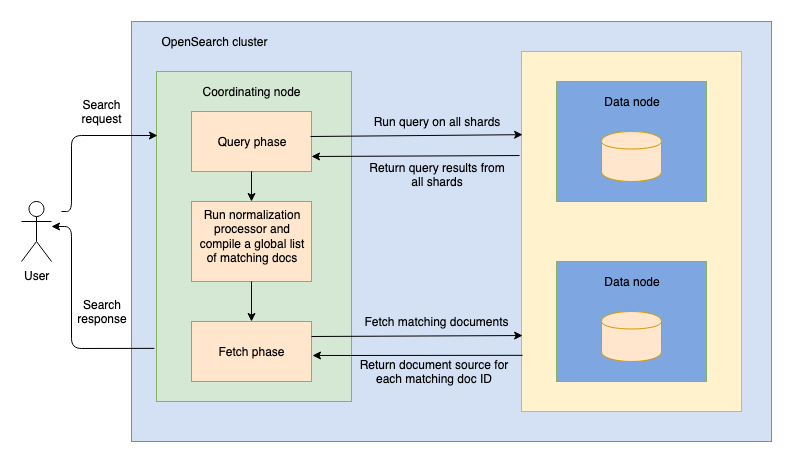Normalization processor
Introduced 2.10
The normalization-processor is a search phase results processor that runs between the query and fetch phases of search execution. It intercepts the query phase results and then normalizes and combines the document scores from different query clauses before passing the documents to the fetch phase.
Score normalization and combination
Many applications require both keyword matching and semantic understanding. For example, BM25 accurately provides relevant search results for a query containing keywords, and neural networks perform well when a query requires natural language understanding. Thus, you might want to combine BM25 search results with the results of a k-NN or neural search. However, BM25 and k-NN search use different scales to calculate relevance scores for the matching documents. Before combining the scores from multiple queries, it is beneficial to normalize them so that they are on the same scale, as shown by experimental data. For further reading about score normalization and combination, including benchmarks and various techniques, see this semantic search blog post.
Query then fetch
OpenSearch supports two search types: query_then_fetch and dfs_query_then_fetch. The following diagram outlines the query-then-fetch process, which includes a normalization processor.

When you send a search request to a node, the node becomes a coordinating node. During the first phase of search, the query phase, the coordinating node routes the search request to all shards in the index, including primary and replica shards. Each shard then runs the search query locally and returns metadata about the matching documents, which includes their document IDs and relevance scores. The normalization-processor then normalizes and combines scores from different query clauses. The coordinating node merges and sorts the local lists of results, compiling a global list of top documents that match the query. After that, search execution enters a fetch phase, in which the coordinating node requests the documents in the global list from the shards where they reside. Each shard returns the documents’ _source to the coordinating node. Finally, the coordinating node sends a search response containing the results back to you.
Request body fields
The following table lists all available request fields.
| Field | Data type | Description |
|---|---|---|
normalization.technique | String | The technique for normalizing scores. Valid values are min_max and l2. Optional. Default is min_max. |
combination.technique | String | The technique for combining scores. Valid values are arithmetic_mean, geometric_mean, and harmonic_mean. Optional. Default is arithmetic_mean. |
combination.parameters.weights | Array of floating-point values | Specifies the weights to use for each query. Valid values are in the [0.0, 1.0] range and signify decimal percentages. The closer the weight is to 1.0, the more weight is given to a query. The number of values in the weights array must equal the number of queries. The sum of the values in the array must equal 1.0. Optional. If not provided, all queries are given equal weight. |
tag | String | The processor’s identifier. Optional. |
description | String | A description of the processor. Optional. |
ignore_failure | Boolean | For this processor, this value is ignored. If the processor fails, the pipeline always fails and returns an error. |
Example
The following example demonstrates using a search pipeline with a normalization-processor.
For a comprehensive example, follow the Neural search tutorial.
Creating a search pipeline
The following request creates a search pipeline containing a normalization-processor that uses the min_max normalization technique and the arithmetic_mean combination technique:
PUT /_search/pipeline/nlp-search-pipeline
{
"description": "Post processor for hybrid search",
"phase_results_processors": [
{
"normalization-processor": {
"normalization": {
"technique": "min_max"
},
"combination": {
"technique": "arithmetic_mean",
"parameters": {
"weights": [
0.3,
0.7
]
}
}
}
}
]
}
Using a search pipeline
Provide the query clauses that you want to combine in a hybrid query and apply the search pipeline created in the previous section so that the scores are combined using the chosen techniques:
GET /my-nlp-index/_search?search_pipeline=nlp-search-pipeline
{
"_source": {
"exclude": [
"passage_embedding"
]
},
"query": {
"hybrid": {
"queries": [
{
"match": {
"text": {
"query": "horse"
}
}
},
{
"neural": {
"passage_embedding": {
"query_text": "wild west",
"model_id": "aVeif4oB5Vm0Tdw8zYO2",
"k": 5
}
}
}
]
}
}
}
For more information about setting up hybrid search, see Using hybrid search.
Search tuning recommendations
To improve search relevance, we recommend increasing the sample size.
If the hybrid query does not return some expected results, it may be because the subqueries return too few documents. The normalization-processor only transforms the results returned by each subquery; it does not perform any additional sampling. During our experiments, we used nDCG@10 to measure quality of information retrieval depending on the number of documents returned (the size). We have found that a size in the [100, 200] range works best for datasets of up to 10M documents. We do not recommend increasing the size beyond the recommended values because higher size values do not improve search relevance but increase search latency.